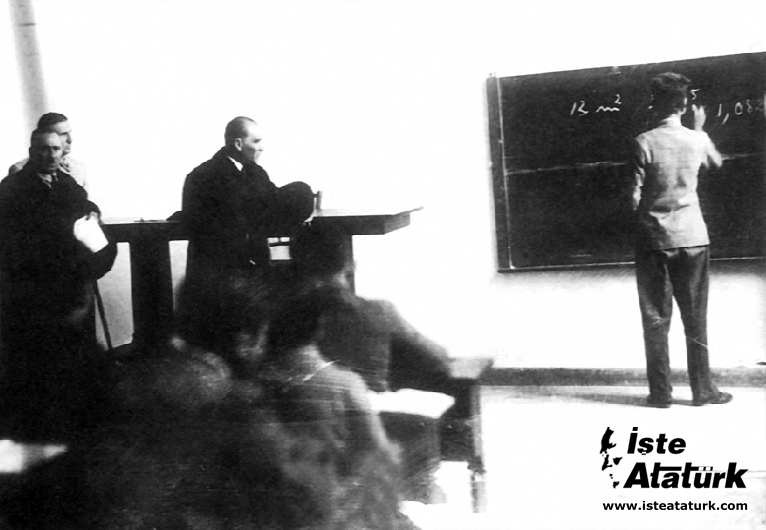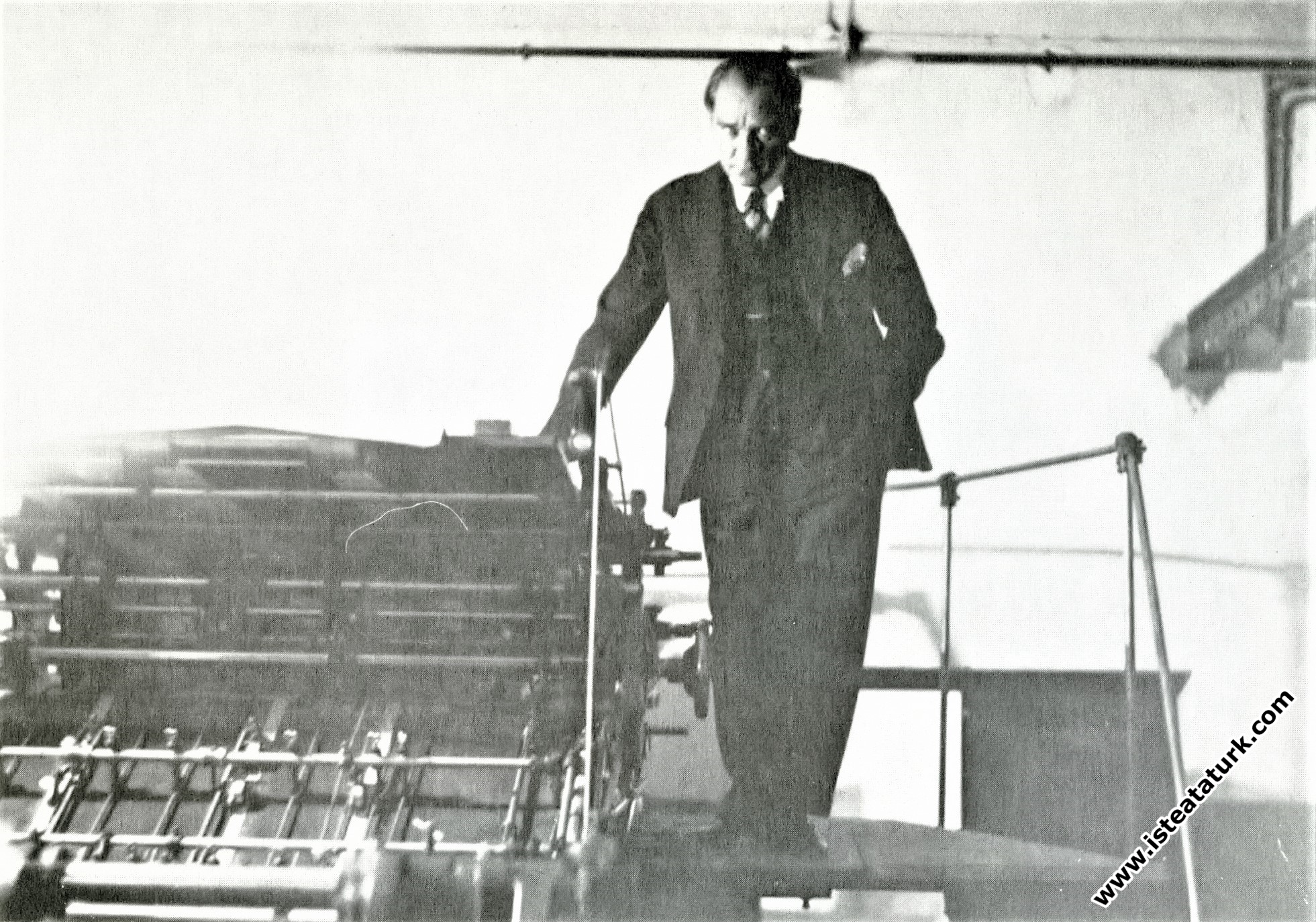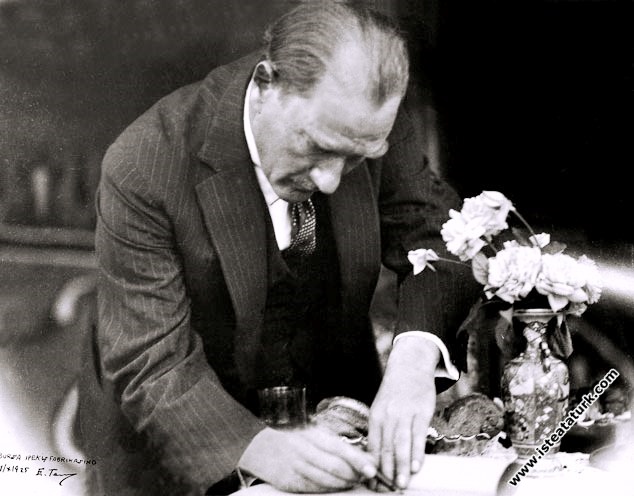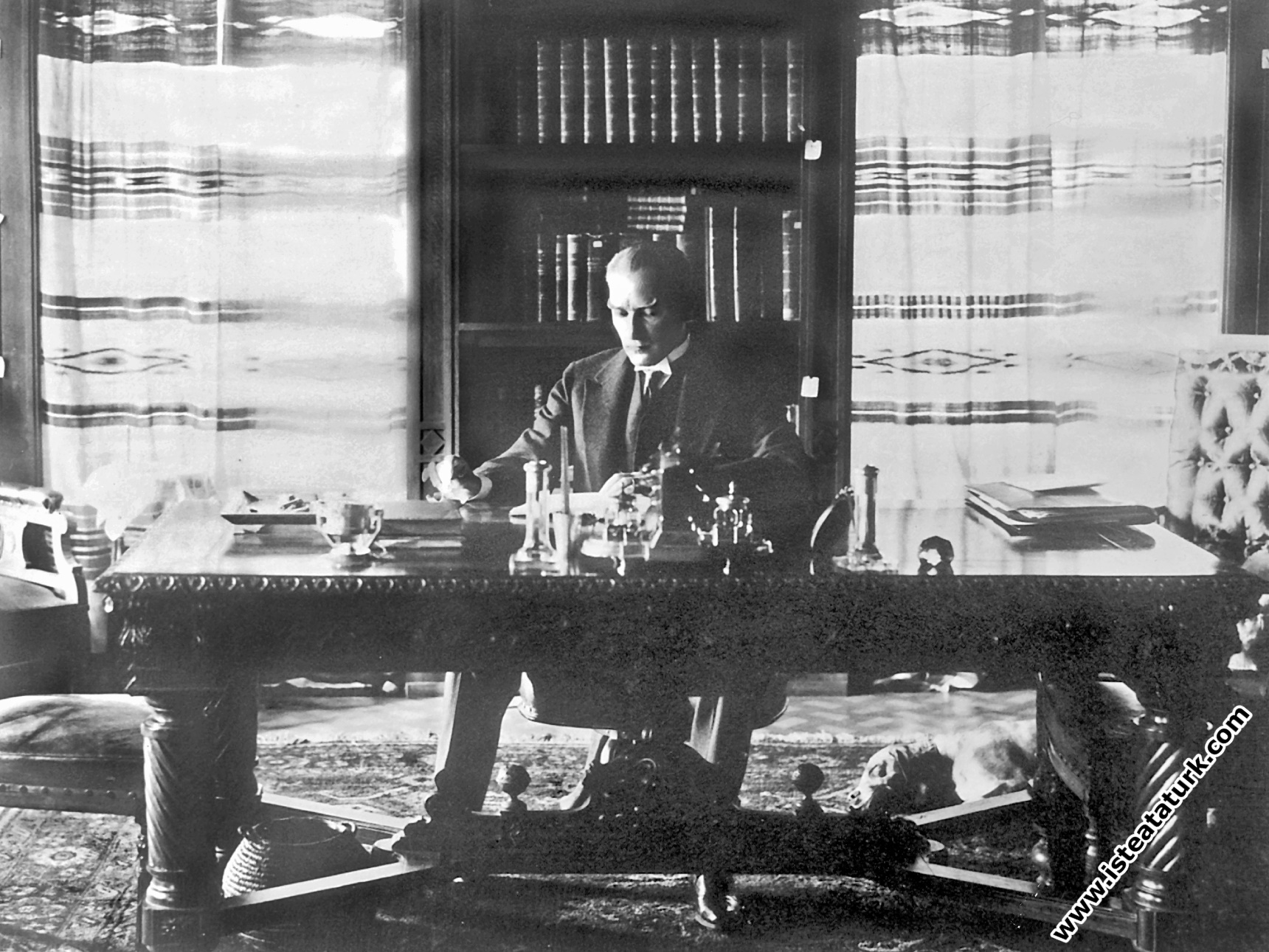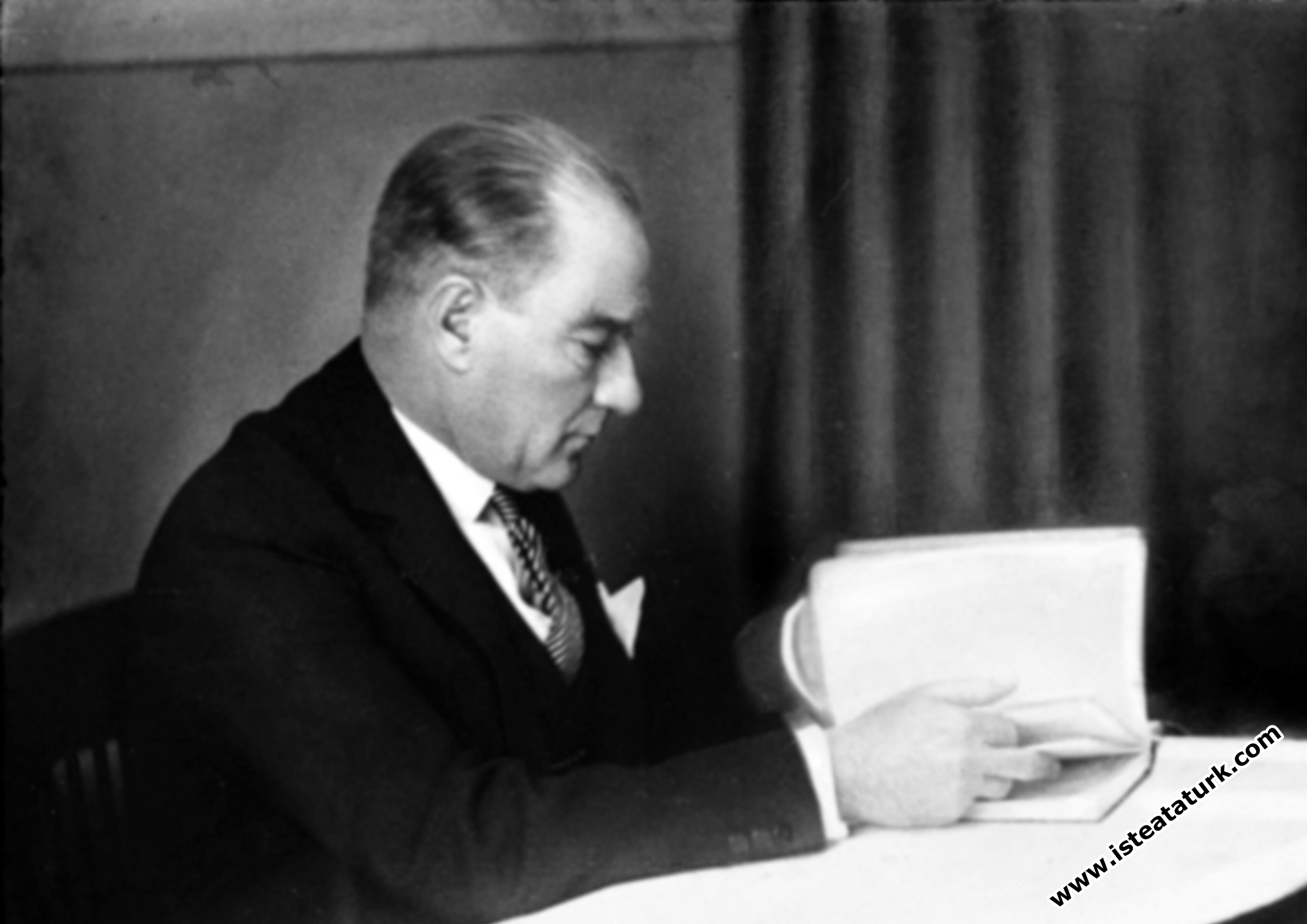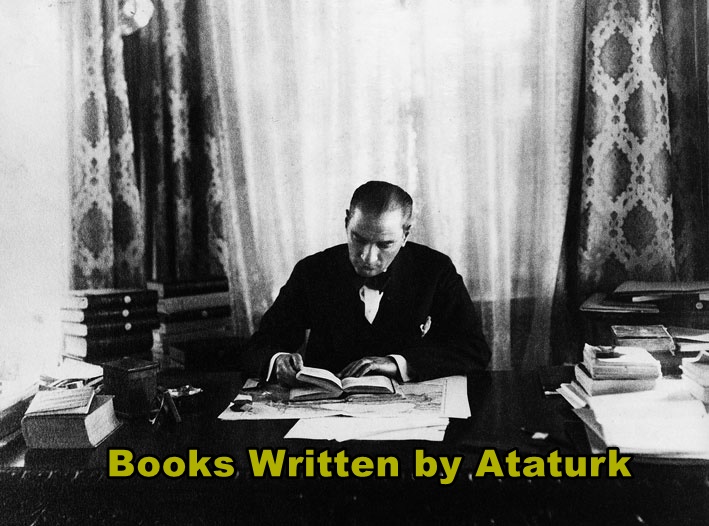
Books Written by Atatürk
Character Size
Mustafa Kemal Atatürk was integrated with the book in every period of his life. Atatürk, who transformed the knowledge provided by this love of reading into writing from time to time, wrote books on different subjects in different periods of his life.
BOOKS WRITTEN BY ATATÜRK
Mustafa Kemal Atatürk was integrated with the book in every period of his life. Atatürk, who transformed the knowledge provided by this love of reading into writing from time to time, wrote books on different subjects in different periods of his life. Even today, his writings contain indisputable facts in terms of both actuality and guidance. The fact that he is still valid today is one of the indicators of his farsightedness and rationality. Mustafa Kemal, especially II. After the declaration of the Constitutional Monarchy (23 July 1908), all his attention and work was focused on military service. He considered it necessary to make publications that would increase professional knowledge. For this purpose, from the first years of his profession, his knowledge about military service has been collected in the books whose names are given below.
1- Nesayih Concerning the Settlement of the Subject Matter and the Copy of the Orders
2- Combat Training of the Team (translation from German - 1908)
3- Cumalı Camp - Cavalry: Company, Regiment, Liva Training and Maneuvers (1909)
4- Medical and Practice Travel (1911)
5- Combat Training of the Division (translation from German - 1912)
6- Hasbihal with Officer and Commander (1918)
7- Speech (1927)
8- Civil Information for the Citizen (published under the name of his spiritual daughter, Afet Inan) (1930)
9- Geometry (published anonymously) (1937)
Speech (Discourse)
Click to download Nutuk as PDF
The Speech, which tells about the War of Independence, a turning point in Turkish history, the foundation of the Republic of Turkey and the making of the reforms, starting from the days when our country was dismembered and occupied, is a first-hand, valuable source work in our political and national history.
This work, which was written by Atatürk himself, was named Nutuk because it was based on a historical speech that lasted 36.5 hours and was read in six days at the Second Congress of the Republican People's Party, which was held in Ankara between 15-20 October 1927. .
Speech not only tells about our past as a story of the past, but also carries a value that can shed light on the present and the future of our national existence with exemplary experiences from our recent history.
Speech is the story of a successful historical flow from the establishment of the Turkish Grand National Assembly to the proclamation of the Republic, by raising the awareness of the nation around the principle of national unity, which will determine the future of the country, and by transforming the concepts of national will and national sovereignty into action.
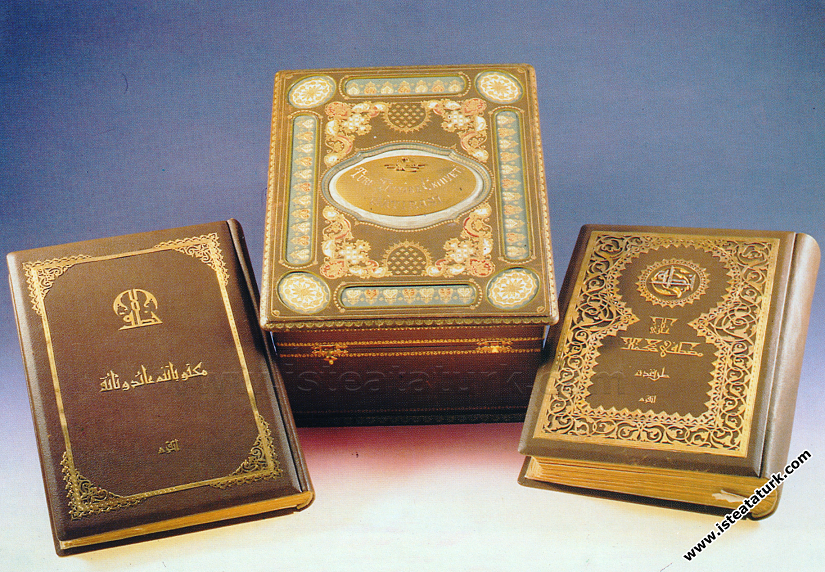
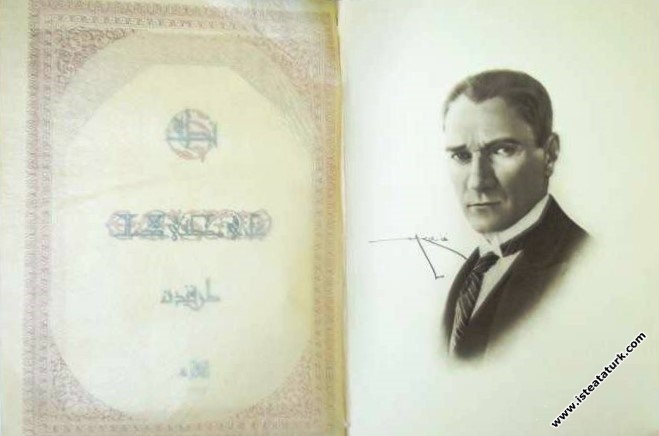
The Nutuk, which was published in a single volume in 1927 and published as a deluxe edition, can be seen.
The Nutuk was first published in 1927 in two volumes, one being the original text and the other documents, in Arabic letters. In the same year, a deluxe edition was published in a single volume. Since this first text became difficult to read after the writing reform, it was reprinted in three volumes by the Ministry of National Education in 1934. Speech has been reprinted by Atatürk Culture, Language and History High Institution Atatürk Research Center.
Combat Training of the Squadron
The work, which was published as "Combat Training of the Company", covers the subjects of combat, defense and attack in residential areas. Subjects that constitute the basis of the defense such as the effect of the restrictive conditions of the residential areas on the battle, the selection of the defensive position, the preparation of the defensive position, the cleaning of the fire areas, the distribution of fire, the closing of the dead zones that do not hold fire and the occupation of the position are covered. In addition, the issues that will always be encountered in the offensive operation, such as the order and order taken by the unit in the offensive, the advance, the superiority of fire, the use of reserves were discussed.
This work, which was translated from the German original and contributed to the training of the army to which it was affiliated, was translated into today's Turkish for the benefit of new generations by Young Staff Chief of Staff Mustafa Kemal (Atatürk).
CURALI CENTRAL
Cumali Camp; It is located on the Köprülü - Štip road in the Macedonian region. In this camp, a cavalry brigade established under the command of Brigadier General Suphi Pasha, Commander of the 3rd Cavalry Division, was trained and maneuvered. Participating in this maneuver, Mustafa Kemal wrote his work "Cumalı Army"; cavalry, company, regiment, brigade training and maneuvers.
As a staff officer, Mustafa Kemal attaches importance to theoretical knowledge, but he does not consider it sufficient that only the participants benefit from military exercises and maneuvers. For this reason, he wrote the observation notes he took during this 10-day exercise, the issues prepared and the criticisms made by the commanders, and turned it into a small brochure with plenty of sketches. This work, which he completed on September 12, 1909, was printed in 1909 in Thessaloniki with printing letters. Work; It consists of 39 pages of text and 7 sketches.
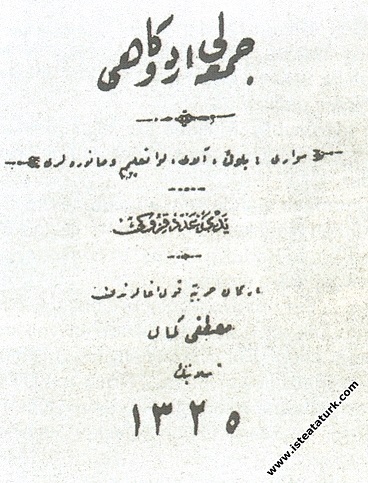
The cover of the first edition of the book " Cumalı Orduğahi "
TEAM COMBAT TRAINING
This book; It constitutes the first part of the work of General Litzmann, one of the former directors of Berlin Military University, titled "Combat Practices of Team, Company and Battalion in the Existence of Mobilization". and it was printed in Thessaloniki Asır Printing House in 1908.
The essence of the book; The application of combat methods in a simple matter, in different weather conditions and in various terrains, of a fully equipped team in an expedition is gathered on the fire battle of a fighter line with the formation of a fighter line.
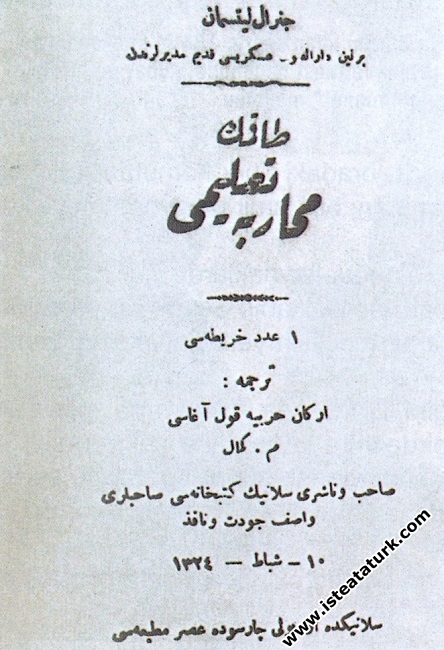
First edition cover of "Team Combat Practice"
Mustafa Kemal Pasha wrote this work, which emphasizes the importance of the exercise, which aims to train officers in the field, in 1911 when he was the Operations Branch Manager of the 5th Corps. In this work, the defense and offensive practices of the red and blue combat units between Thessaloniki and Kilkis were evaluated.
TACTICAL AND EXERCISING TRIP
In this work, besides emphasizing the lack of certain rules in the conduct of a war, he also emphasized the qualities of the person who is a commander. These are; superior success in educating, directing and protecting the troops in peace and war, the power of thought that will make up for the lack of power in his hands, and to gain superiority over his subordinates in every matter. In addition, there must be personal courage, the ability to anticipate the actions of others and to act at the most appropriate time. In order to achieve the common goal, he must successfully manage his troops, be effective over his subordinates and establish his authority.
In this work, it is also stated that for a commander to be successful, it is not enough to just read and learn these rules, and the importance of their application is also stated.
MARITAL INFORMATION FOR CITIZEN
Beginning from the 1930s, it was taught for many years and Prof. Dr. A large part of this important work named "Civil Information for Citizens" written by Afet Afetinan was written by Gazi Mustafa Kemal Atatürk himself. It is known that Atatürk gave great importance to these courses, which were later taught under the name of "Citizenship" in educational institutions. With this important work, Atatürk tried to enlighten and raise awareness about the rights and duties of citizenship to the generation that he sees as the future of the Republic of Turkey, thus he explained how a civilized and modern society should be to the generations that will take over the administration of the country in the future. This work is of great importance in this respect.
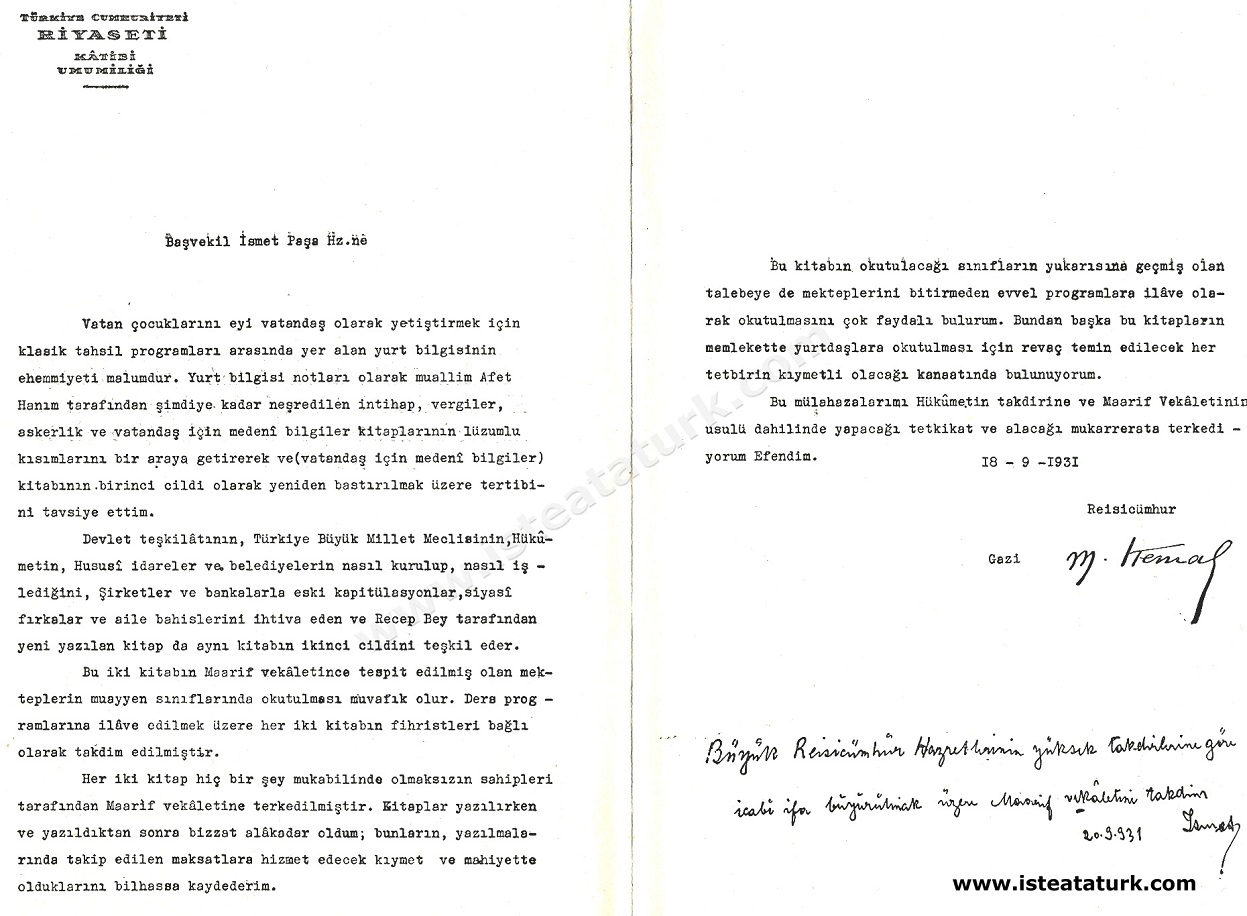
Atatürk's letter to İsmet İnönü for his book Civil Information for the Citizen.
Civil Information for the Citizen II book cover
The Subject Headings of the Work Written by Atatürk entitled Citizenship Information
- nation
- Social Freedom
- Emergences of Other Nations
- Kinds of Freedom
- General Description of the Nation
- Kamuoyu
- Nationalization Principle
- Self-Organization of the Public
- Turkish Nationalism
- Newspapers
- State
- Freedom of Association and Education
- Domination
- Establishing an Association
- State Forms
- Freedom of Education
- Content of the Principle of Democracy
- The Right to Notify and Complain
- Historical Development of the Principle of Democracy
- Individual and Political Rights
- Distinctive Characteristics of the Principle of Democracy
- Protection and Sanctions of Freedom
- Republic
- Overcoming Bigotry (Tolerance)
- Our Constitution
- Work sharing
- Contemporary Movements Against Democracy
- Solidarity
- Duties of the State Against the Citizen
- Working Profession
- Freedom
- How to Choose a Profession and How to Perform it
- The Historical Development of Freedom
- Duties of Citizens to the State
- Individual Freedom
BOOK OF GEOMETRY
Click to download as PDF
Atatürk published this book one and a half years before his death. He wrote it in his own hand in the Dolmabahçe Palace in the winter months of 1936-1937, right after the Turkish Language Congress. Atatürk thought that textbooks full of Arabic and Persian terms would delay learning for students.
Atatürk came to Sivas High School where Sivas Congress was held, High School Principal and Mathematics teacher Ömer Beygo and his Assistant Philosophy teacher Faik Dranaz and other interested persons came to the Congress hall. Here, he first visited the Congress hall and private room where the historical congress was held on September 4, 1919, and told his memories of that day in this room and hall, whose decor of that day was preserved exactly. Then, as a group, he entered Hendese (Geometry) course in the 9/A class of the High School. In this lesson, he put a female student at the blackboard. The student had difficulty in saying the Arabic names of the angles formed by the intersection of two parallel lines drawn on the board and made mistakes. Impressed by this situation, Atatürk responded by saying, “Students cannot be informed in these incomprehensible Arabic terms. Lessons should be explained in Turkish with new terms.
While explaining the origin of the term "parallel", which he used to replace the word "parallel", which is equivalent to "parallel" in our language, Atatürk explained that the Turks in Central Asia called the stance of the two wheels of their carts connected to an axle as "para". In this course, Atatürk also ordered that the textbooks be printed in Turkish terms within a few months and delivered to all schools.
.png)

Geometry book cover
The work is under the title of "Starting Recipes"; It begins with the explanation of the three dimensions that exist in objects. Then the volume is explained. After specifying the difference between the volume and the surface, the line is defined. Explain how geometry is a science. The work consists of three parts.
In the first part; After explaining the various lines, the meaning of the words diameter, radius, beam, arrow, cross, touch is explained by giving examples of daire, arc, degree under the title of circle. After the explanation of the word parallel, angle definition is made and various angles are explained with examples. Afterwards, the various situations of the straight line are discussed and straight, oblique, horizontal lines are explained with examples, the definition of angles formed from these lines and their calculations in degrees are explained with an example. Polygons defined as part of a level fenced by multiple sides; After explaining the triangles, quadrilaterals, pentagons, hexagons, heptagons and octagons, the types of triangles and their angle values are also explained with examples under the name of parallelogram, vertical quadrilateral, rhombus, square and trapezoidal quadrilaterals.
Second Part; It is devoted to the Measurement of Levels. In the first part, how to calculate the area of the geometric shapes defined is expressed in writing, and this expression is exemplified by mathematical operations. Different solutions are also shown in the operations of area calculations of some levels and an example of this is also included in the work. In addition, the ratio calculations between the perimeters and areas of symbolic figures are shown with examples.
The third part is under the title of Solids; In addition to the explanations of cylinder, roughness, cone, pyramid and heart, how to do area and volume operations is expressed with examples given.
An index is given under the heading 'Atatürk's terms used and defined in his geometry book' in the last part of the work. It has been stated that the number of terms used and defined by Atatürk is one hundred and twenty-nine, these terms are given in alphabetical order, and the definitions of the terms are made as faithful as possible to Atatürk's style and writing. However, it was stated that only minor changes were made in the syntax so that some definitions could be given in the dictionary order.
Geometry terms that Atatürk brought to our Turkish; angle, bisector, area, plus, pentagon, dimension, over, diameter, cross, plumb, circle, exterior angle, vertical, quadrilateral, vertical, level, oblique, minus, equal, equilateral, justification, interior obtuse, isosceles, section, position, diagonal, ratio, proportion, parallelogram, base, tangent, sum, derivative, space, space, triangle, assumption, trapezoid, horizontal, congruent.
Source: “A Historical Memoir”, Bilim ve Teknik, Öner Kol November 1981, Issue: 180, page:16.
Atatürk wrote the Geometry book:
Agop Dilacar Tells:
"Atatürk wrote the Geometry book with his own hand, one and a half years before his death, in the winter months of 1936-1937, right after the Third Turkish Language Congress (August 24-31, 1936).
One day in the autumn of 1936, Atatürk sent me to Haşet Kitabevi in Beyoğlu with his Chief of Staff, Süreyya Anderiman, and had one of the French Geometry books taken out, which we deemed appropriate. After these were reviewed together with Atatürk, the general design of the Geometry book to be written was drawn. After a while, I left and Atatürk worked on this work during the winter months. The geometry book is the product of this labor.
Source: Agop Dilâçar, “Foreword” of the book “Geometry”, Turkish Language Institution Publication, 1981, p.V.
This work of Atatürk, which he wrote between January 10 and March 9, 1937, was published by the Ministry of National Education at the State Printing House in 1937. In this book, called “Geometry”, the following entry is written: “For those who teach geometry and those who will write books on this subject. It has been published by the Ministry of Culture as a guide”.
TALKS WITH THE OFFICER AND THE COMMANDER
"Conversations with Officers and Commanders" is one of Atatürk's most important works on military service. This work was written in response to Nuri Conker's book "Officer and Commander (Officer and Commander)" when Atatürk was a Military Attaché in Sofia with the rank of Staff Lieutenant Colonel in 1914.
How the young officer sensed the faults and faults in the army he was in; how he presented mistakes and solutions to the higher authorities by not being unresponsive to them; In the first part of the book, we find the suffering of the country's military and political situation.
Atatürk agreed with Nuri Conker's views on the self-sacrifice that an officer should bear, risking death, being able to lead and administer those under his command, the spirit of attack, and his initiative characteristics, and he explained his own thoughts by supporting them with various examples.
In addition to these, she could not help herself from revealing with all its clarity that the Turkish woman chose silence when she could actually be very effective in creating the society. About the Turkish nation, he said, "Undoubtedly, the character of our nation, like all other characters, is suitable to rise and take the desired shape. But on the condition that it is on its own...", he emphasized that the effects desired to be made on the character of our nation from the outside cannot reach their goal.
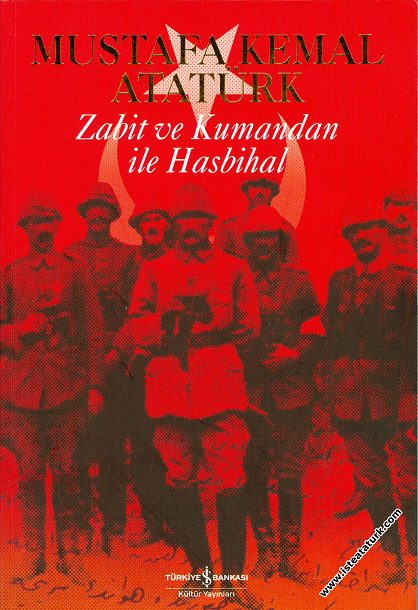
The cover of the book published by Türkiye İş Bankası Publishing in 2006
Atatürk, who devoted a large section to the initiative feature of officers and privates in his work, compared the Ottoman army in his own period with the previous periods. Especially with the experiences he gained in the Tripoli War, he showed the necessary limits of his ability to act and work on his own.
In the last part of the work, Atatürk commemorated his fearless and valiant comrades-in-arms with whom he fought in North Africa and described them as people with "high military qualifications". This behavior bears witness to his humane side as well as all his other superiorities.
Summary of Hasbihal with the Officer and Commander
CHAPTER ONE : INTRODUCTION (Nuri CONKER)
In the introduction, war history gives experience to soldiers, war games and exercises are imitations of war, the real experience is gained through war, many commanders gain experience by experiencing the war personally, the German army even risks war to gain this experience, war is learned in war, countries and armies are always ready to fight. emphasis is placed on being ready.
It is mentioned that the proliferation and development of weapon systems requires a multitude of information to be learned. The Balkan defeat of the army is emphasized and its reasons are investigated. With an emphasis on the human factor; It is emphasized that even technical knowledge, which will not be crowned with outstanding human qualities and superior morality worthy of sacrifice, will not be sufficient to achieve success.
CHAPTER TWO : OFFICERS EARN THE HEARTS AND CONFIDENCE OF PRISONERS AND SUPPORT THEIR MORAL STRENGTH
Nuri CONKER in the second part; Since the officers should recognize the soldiers as their own children, discipline is the foundation of the army, it would be appropriate for every soldier to do the job according to the wishes of their superiors and superiors, the officers should be understanding while training the soldiers, and the weapon should be taught well because it is the most effective tool in eliminating the enemy who is eyeing our country. speaks of the need.
He mentions that the ceremonies to be held in the troops will motivate the soldiers in a positive way, and the holiness and spiritual value of the union banners, and the necessity for the soldiers and the officers who govern them to be very close to each other and to know each other.
SECTION THREE : THE IDEA OF ATTACK
In this section, it is mentioned that the war means an attack, and that the attack will subdue the enemy. Nuri CONKER writes that defense will force the army to submit to the will and will of the enemy. He writes that every kind of work and preparation of the army is for the purpose and purpose of attacking and gives examples in this regard from history.
CHAPTER FOUR : Spontaneous WORKING AND ASSEMBLING RESPONSIBILITY
In the fourth chapter, Nuri CONKER writes that the greatest and superior qualification of an officer is to be necessary and passionate to work on his own with the ability to apply. He gives examples from the instructions by stating that this issue, which we call initiative, will be provided by superiors and officers who do not expect orders from above. Nuri CONKER briefly in this section; He dictates that every commander should have the ability to function spontaneously.
PART TWO : OFFICER AND COMMANDER AND HASBIHAL (Mustafa Kemal ATATÜRK)
In the second part of the book, Mustafa Kemal ATATÜRK chats with Nuri CONKER's book named Officer and Commander and writes his answers. This part of the book consists of six chapters.
CHAPTER ONE :
In this section, ATATÜRK writes that he read the book late, but that he liked it very much, that the army may fail under the management of shortsighted and ignorant commanders, and that officers should always read and renew themselves. He states that he thinks about what Nuri CONKER has written on these issues and that he generally agrees with him.
PART TWO :
In this section, ATATÜRK states that he agrees with Nuri CONKER's thoughts on the sense of self-sacrifice and self-sacrifice of soldiers. Emphasizing that the countries surrounding Turkey are raising their young generations against TURKEY, they want measures to be taken accordingly.
PART THREE :
In this section, Mustafa KEMAL emphasizes that every member of the Turkish nation, starting from the family and during his military service, should be brought up with sublime feelings by going deep into the spiritual depths of the person.
CHAPTER FOUR :
In this section, Atatürk explains that the most reliable tool of success is the attack, but the nation that will bring the attack army into existence must have the spirit of attack.
SECTION FIVE :
In this chapter, Mustafa Kemal ATATÜRK advises that an operation may rarely proceed as planned, that many factors may change, and that in these situations, which can change at work, the soldiers will use their own initiative and decide and implement them without waiting for orders from anyone.
CHAPTER SIX :
In the last part of the book, ATATÜRK gives examples from his life and memories about the most important qualities of military service, such as disregard for life, offensive thinking and spontaneous action.
Translated by Emre Taylan - 176 pages, 2nd paste, Türkiye İş Bankası Publishing, ISBN: 9754587566; Size: 16x24cm; Print Date: June 2006, Original Language: Turkish
